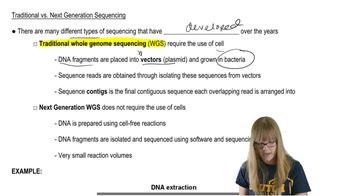Additional STR allele frequency information can be added to improve the analysis in Problem 8. The frequency of D8S1179₁₂ = 0.12. The frequency of D16S539₁₈ = 0.08 and of D16S539₂₀ = 0.21. Lastly, D18S51₁₉ = 0.13 and D18S51₂₀ = 0.10. Combine the allele frequency information for these three STR genes with the information used in Problem 8 to calculate the frequency of the genotype for six of the STR genes.
Table of contents
- 1. Introduction to Genetics51m
- 2. Mendel's Laws of Inheritance3h 37m
- 3. Extensions to Mendelian Inheritance2h 41m
- 4. Genetic Mapping and Linkage2h 28m
- 5. Genetics of Bacteria and Viruses1h 21m
- 6. Chromosomal Variation1h 48m
- 7. DNA and Chromosome Structure56m
- 8. DNA Replication1h 10m
- 9. Mitosis and Meiosis1h 34m
- 10. Transcription1h 0m
- 11. Translation58m
- 12. Gene Regulation in Prokaryotes1h 19m
- 13. Gene Regulation in Eukaryotes44m
- 14. Genetic Control of Development44m
- 15. Genomes and Genomics1h 50m
- 16. Transposable Elements47m
- 17. Mutation, Repair, and Recombination1h 6m
- 18. Molecular Genetic Tools19m
- 19. Cancer Genetics29m
- 20. Quantitative Genetics1h 26m
- 21. Population Genetics50m
- 22. Evolutionary Genetics29m
18. Molecular Genetic Tools
Methods for Analyzing DNA
Problem 9e
Textbook Question
Which of the examples of genetic testing below are prognostic tests? Which are diagnostic?
An adult diagnosed with Asperger syndrome (AS) has a genetic test that reveals an SNP in the GABRB3 gene that is significantly more common in people with AS than the general population.
 Verified step by step guidance
Verified step by step guidance1
Understand the difference between diagnostic and prognostic tests: Diagnostic tests are used to confirm or rule out a specific genetic condition in an individual who is showing symptoms. Prognostic tests, on the other hand, provide information about the likely course or outcome of a condition, often predicting the severity or progression of a disease.
Analyze the scenario: The individual has already been diagnosed with Asperger syndrome (AS). The genetic test is being used to identify a SNP (single nucleotide polymorphism) in the GABRB3 gene that is more common in people with AS than in the general population.
Determine the purpose of the test: Since the individual is already diagnosed with AS, the test is not being used to confirm the diagnosis. Instead, it is identifying a genetic variant associated with the condition, which could provide information about the genetic basis or potential progression of AS.
Classify the test: Based on the purpose, this test is more aligned with a prognostic test because it provides additional information about the genetic factors associated with AS rather than diagnosing the condition itself.
Conclude: The genetic test in this scenario is a prognostic test, as it is not used to diagnose AS but rather to explore genetic associations that may have implications for understanding the condition's progression or characteristics.
 Verified video answer for a similar problem:
Verified video answer for a similar problem:This video solution was recommended by our tutors as helpful for the problem above
Video duration:
1mPlay a video:
Was this helpful?
Key Concepts
Here are the essential concepts you must grasp in order to answer the question correctly.
Prognostic vs. Diagnostic Testing
Prognostic tests are used to predict the likelihood of developing a disease or the likely course of an existing disease, while diagnostic tests are used to confirm or rule out a specific condition. Understanding the distinction is crucial for interpreting genetic test results, as it informs whether the test is assessing risk or confirming a diagnosis.
Recommended video:
Guided course

Traditional vs. Next-Gen
Single Nucleotide Polymorphism (SNP)
A Single Nucleotide Polymorphism (SNP) is a variation at a single position in a DNA sequence among individuals. SNPs can influence how individuals respond to diseases, medications, and environmental factors, making them significant in genetic testing for both diagnostic and prognostic purposes.
Recommended video:
Guided course

Recombination after Single Strand Breaks
GABRB3 Gene and Asperger Syndrome
The GABRB3 gene encodes a subunit of the GABA receptor, which is involved in inhibitory neurotransmission in the brain. Variations in this gene have been associated with neurodevelopmental disorders, including Asperger syndrome, highlighting the importance of genetic testing in understanding the genetic basis of such conditions.
Recommended video:
Guided course

Mapping Genes

 7:40m
7:40mWatch next
Master Methods for Analyzing DNA and RNA with a bite sized video explanation from Kylia
Start learningRelated Videos
Related Practice
Textbook Question
430
views
